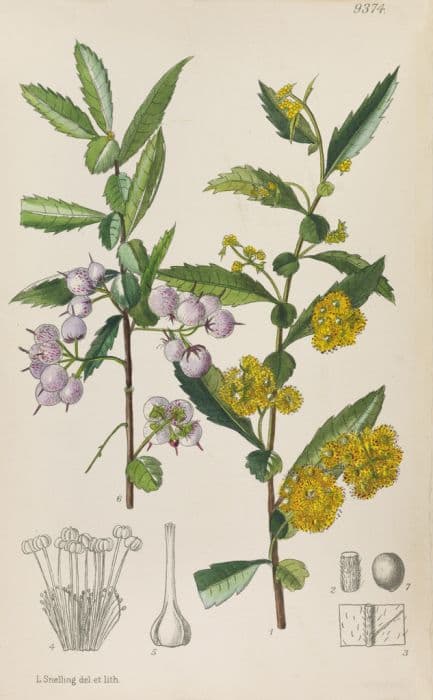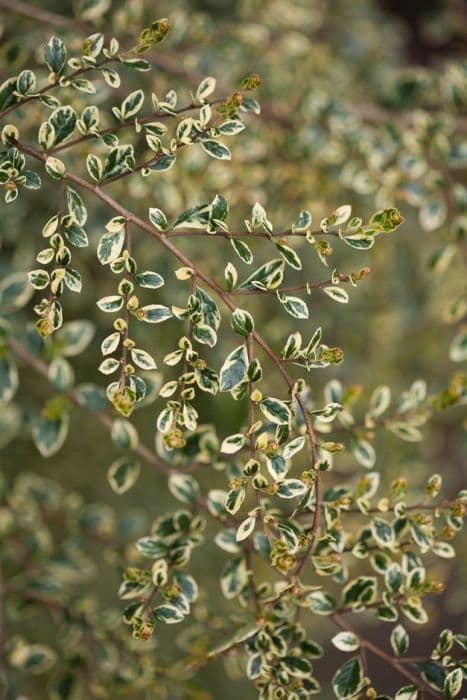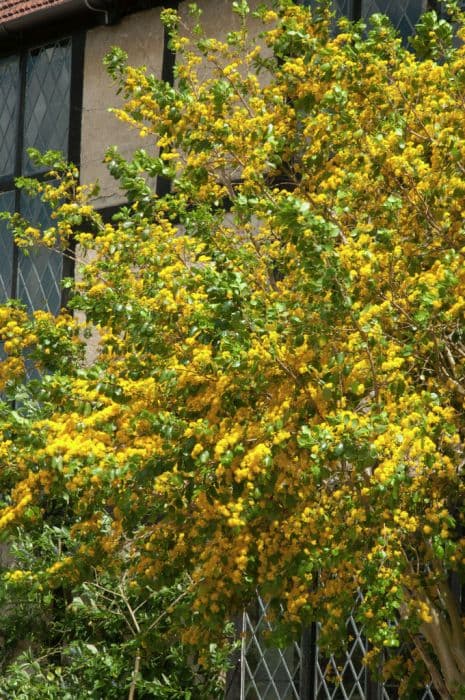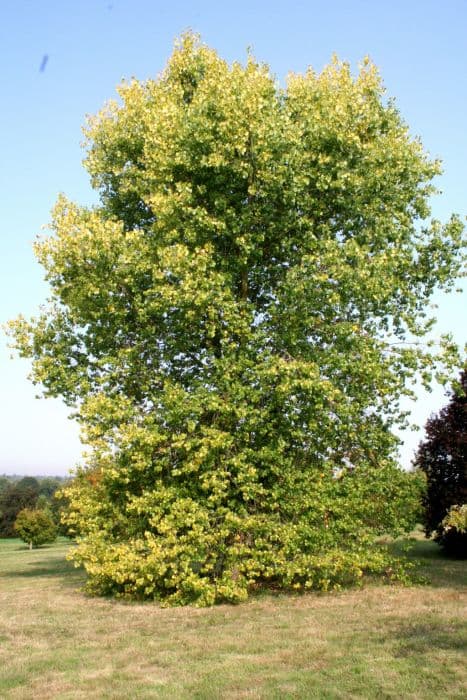Kilmarnock willow Salix caprea 'Kilmarnock' (m)

ABOUT
Salix caprea 'Kilmarnock', commonly known as Kilmarnock willow or weeping pussy willow, is a small, ornamental deciduous tree with a distinctive weeping habit. Its branches gracefully arch downwards, giving the plant an elegant, fountain-like shape. In spring, the Kilmarnock willow produces an abundance of silver-gray catkins that eventually turn yellow with pollen, attracting bees and other pollinators. The catkins appear before the leaves and provide early interest in the garden. As the seasons change, the foliage emerges as a fresh green, turning to elongated, lance-shaped leaves which provide a lush backdrop for other seasonal blooms. The leaves often acquire a golden hue in the fall, adding a warm touch to the autumn landscape. The bark of the Kilmarnock willow is textured and can be an attractive feature in the winter garden when the leaves have fallen. Overall, the appearance of the Kilmarnock willow is one of peaceful, cascading greenery that is especially suited to smaller garden spaces where its charming form can be appreciated up close.
About this plant
 Names
NamesFamily
Salicaceae.
Synonyms
Kilmarnock Willow, Weeping Goat Willow, Pendula.
Common names
Salix caprea 'Pendula', Salix caprea 'Weeping Kilmarnock'
 Toxicity
ToxicityTo humans
Weeping willow (Salix caprea 'Kilmarnock') is generally considered non-toxic to humans. However, like many plants, it could potentially cause minor digestive discomfort if ingested, partly due to the presence of salicin, a chemical relative of aspirin. Although poisoning is not common, consuming parts of this plant may lead to symptoms similar to aspirin overdose, such as stomach pain, nausea, vomiting, or diarrhea.
To pets
Weeping willow (Salix caprea 'Kilmarnock') is also considered non-toxic to pets. However, as with humans, ingestion of parts of this plant could potentially result in mild gastrointestinal upset in some animals. It is not commonly associated with severe toxicity or serious consequences if pets consume it, but if a pet ingests a large amount of the plant and shows adverse symptoms, it is advisable to consult a veterinarian.
 Characteristics
CharacteristicsLife cycle
Perennials
Foliage type
Deciduous
Color of leaves
Green
Flower color
Varies
Height
6-8 feet (1.8-2.4 meters)
Spread
6-8 feet (1.8-2.4 meters)
Plant type
Shrub
Hardiness zones
4
Native area
Europe
Benefits
 General Benefits
General Benefits- Ornamental Value: Salix caprea 'Kilmarnock', commonly known as Kilmarnock willow, has a highly decorative weeping form that is attractive throughout the year, providing aesthetic enhancement to gardens and landscapes.
- Wildlife Attraction: The catkins are a valuable source of early nectar and pollen for bees and other pollinators, making this plant beneficial for supporting local ecosystems.
- Small Spaces: It is suitable for small gardens due to its modest size and weeping habit, maximizing the use of limited space.
- Low Maintenance: Kilmarnock willow requires minimal pruning and upkeep once established, making it a convenient option for busy gardeners.
- Adaptability: It can grow in a range of soil types and is tolerant of different moisture levels, which allows for flexibility in site selection.
- Seasonal Interest: With its early spring catkins, vibrant green leaves in summer, and yellow autumn foliage, this willow provides year-round interest.
 Medical Properties
Medical Properties- This plant is not used for medical purposes.
 Air-purifying Qualities
Air-purifying QualitiesThis plant is not specifically known for air purifying qualities.
 Other Uses
Other Uses- Crafting Baskets: The flexible branches of the 'Kilmarnock' willow can be harvested and woven into baskets and other decorative items.
- Living Structures: Skilled gardeners can train growing 'Kilmarnock' willows into living structures like tunnels, arbors, or even playful sculptures in the garden.
- Erosion Control: Its root system helps stabilize the soil, making 'Kilmarnock' willows a good choice for planting along riverbanks or areas prone to erosion.
- Noise Barrier: The dense foliage and twigs can act as a natural sound barrier, making them suitable for planting in urban areas to reduce traffic noise.
- Privacy Screen: Due to its bushy growth habit, 'Kilmarnock' willows can be used to create a privacy screen in gardens and outdoor living spaces.
- Windbreak: Planted in rows, these trees can serve to break the force of the wind, protecting gardens or properties from wind damage.
- Biomass Production: 'Kilmarnock' willows grow quickly and can be harvested for biomass energy production.
- Artistic Medium: The wood of the 'Kilmarnock' willow can be used by artists for carving or turning on a lathe to make wooden objects.
- Aquatic Habitats: When planted near ponds, they can provide shelter and habitat for aquatic wildlife such as frogs and dragonflies.
- Winter Interest: With its distinctive weeping form and pussy willows that emerge in late winter, 'Kilmarnock' willows add visual interest to the garden during the colder months.
Interesting Facts
 Feng Shui
Feng ShuiThe Weeping Willow is not used in Feng Shui practice.
 Zodiac Sign Compitability
Zodiac Sign CompitabilityThe Weeping Willow is not used in astrology practice.
 Plant Symbolism
Plant Symbolism- Flexibility: The pliant branches of the Kilmarnock willow (a common name for Salix caprea 'Kilmarnock') symbolize flexibility and adaptability, as the branches tend to be flexible and can bend without breaking.
- Grief and Mourning: Willows, in general, are often associated with sorrow and mourning, partly because their drooping branches convey a sense of weeping or sadness.
- Healing: Historically, the willow has also been connected to healing due to the salicylic acid found in its bark, which is the basis for making aspirin, a well-known pain reliever.
- Feminine and Maternal Qualities: The Kilmarnock willow's soft, flowing appearance can represent femininity and maternal attributes, often associated with the nurturing aspects of nature.
- Inner Vision and Dreams: Some cultures believe that the willow has the power to enhance psychic abilities and facilitate vivid dreams, symbolizing inner vision and the link between the conscious and subconscious minds.
 Water
WaterKilmarnock Willow requires consistent moisture, especially during its growing season in spring and summer. Water it deeply, ensuring the water reaches the root zone, about once a week. During hot or dry periods, you may need to water twice a week. Depending on the size of the tree and the weather conditions, you should aim to provide approximately 10 to 15 gallons of water each time. In the fall and winter, you can reduce the frequency to every two weeks, or when the soil feels dry to the touch a couple of inches deep.
 Light
LightThe Kilmarnock Willow thrives best in full sun to partial shade. This plant should be placed in a location where it can receive at least 6 hours of direct sunlight per day. However, it can tolerate some shade, especially during the hottest part of the day. The ideal spot would be one where morning sun is abundant, and afternoon light is dappled or partially shaded, as this helps prevent excessive heat stress.
 Temperature
TemperatureKilmarnock Willows are hardy and can tolerate a wide range of temperatures, but they perform best when the temperature is between 50°F and 75°F. They can survive in temperatures as low as -20°F and as high as 90°F, but extreme temperatures should be avoided. To ensure the health of this plant, avoid placing it in areas where temperature fluctuations are extreme and sudden.
 Pruning
PruningPruning the Kilmarnock Willow encourages healthy growth and a pleasing shape. It is best pruned in late winter or early spring before new growth starts. Remove any dead, damaged, or diseased branches and thin out overcrowded areas to allow light and air to penetrate the canopy. Annual pruning is typically sufficient for maintaining the tree's weeping habit and overall health.
 Cleaning
CleaningAs needed
 Soil
SoilKilmarnock Willow thrives best in consistently moist, well-draining soil with a slightly acidic to neutral pH, ideally ranging from 5.5 to 7. The best soil mix can be achieved by blending loam with peat and sand to ensure proper drainage and moisture retention.
 Repotting
RepottingKilmarnock Willows, being a dwarf weeping cultivar, can be grown in large containers and should ideally be repotted every 2 to 3 years to refresh the soil and to accommodate the growth of the root system.
 Humidity & Misting
Humidity & MistingKilmarnock Willow prefers outdoor conditions and does not require specific humidity levels being met, as it is quite adaptable and can tolerate the natural humidity levels found in most temperate climates well.
 Suitable locations
Suitable locationsIndoor
Not ideal for indoor growth; requires full sun.
Outdoor
Plant in full sun with moist, well-drained soil.
Hardiness zone
4-8 USDA.
 Life cycle
Life cycleThe Kilmarnock willow (Salix caprea 'Kilmarnock'), a male clone often grown as an ornamental plant, starts its life cycle from a cutting or graft ideally taken in the dormant season. Once rooted, this deciduous tree undergoes a juvenile phase where it rapidly grows and develops its characteristic weeping form. In spring, before the leaves appear, it displays prominent catkins, which are silver at first and later turn yellow as the pollen matures. After pollination, which is carried out by insects or wind, it doesn't produce seed because it is a sterile cultivar. Throughout the summer, the Kilmarnock willow forms a dense canopy of leaves, which it sheds in autumn as it enters dormancy. The plant can live for several decades, during which it will regularly enter a rejuvenation phase if pruned well, sustaining its ornamental appeal.
 Propogation
PropogationPropogation time
Late winter
The most popular method of propagating a Kilmarnock willow, which is a grafted cultivar of Salix caprea, is through hardwood cuttings. This is usually done during the plant's dormant period, typically late fall to late winter. To propagate, one takes cuttings of mature wood of the current year's growth, measuring about 7-10 inches (approximately 18-25 cm) in length. Each cutting should have several buds. The cutting's lower end is then dipped in rooting hormone and planted in a mixture of sand and peat, ensuring at least a few buds are above the soil surface. It is important to keep the soil moist but not waterlogged. Roots and shoots should begin to appear in the spring, once warmer temperatures trigger the growth cycle.









